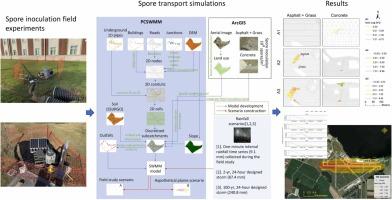Journal of Hazardous Materials ( IF 12.2 ) Pub Date : 2023-06-02 , DOI: 10.1016/j.jhazmat.2023.131747 Lifeng Yuan 1 , Anne M Mikelonis 1 , Eugene Yan 2

|
To assist in emergency preparedness for a biological agent terrorist attack or accidental pathogen release, potential contaminant levels and migration pathways of spores spread by urban stormwater were evaluated using a Storm Water Management Model (SWMM) of U.S. Coast Guard Base Elizabeth City, North Carolina. The high temporal-spatial resolution SWMM model was built using spore concentrations in stormwater runoff from asphalt, grass, and concrete collected from a point-scale field study. The subsequent modeled contamination scenarios included a notional plume release and point releases mimicking the field study under three rainfall conditions. The rainfall scenarios included a 6-hour natural rainfall event on Dec. 8, 2021 and two design storms (2-year and 100-year events). The observed spore concentrations from asphalt and concrete from the actual field experiment were applied to calibrate the washoff parameters in the SWMM model, using an exponential washoff function. The calibrated washoff coefficient (c1) and exponent (c2) were 0.01 and 1.00 for asphalt, 0.05 and 1.45 for grass, and 2.45 and 1.00 for concrete, respectively. The calibrated SWMM model simulated spore concentrations in runoff at times and magnitudes similar to the field study data. In the point release modeled scenario, the concrete surface generated 55.6% higher average spore concentrations than asphalt. Similarly, in the field experiment, a 175% (p < 0.05) higher average spore concentration in surface runoff was observed from concrete than from asphalt. This study demonstrates how SWMM may be used to evaluate spore washoff from urban surfaces under different precipitation amounts, intensities, and durations, and how visualized spatial migration pathways in stormwater runoff may be used for emergency planning and remediation.
中文翻译:

使用 SWMM 进行应急响应规划:评估各种降雨情景和城市表面下生物剂输送的案例研究
为了协助做好生物制剂恐怖袭击或病原体意外释放的应急准备,使用北卡罗来纳州伊丽莎白市美国海岸警卫队基地的雨水管理模型(SWMM)评估了城市雨水传播的潜在污染物水平和孢子迁移途径。高时空分辨率 SWMMH 模型是利用从点尺度现场研究中收集的沥青、草地和混凝土雨水径流中的孢子浓度建立的。随后模拟的污染情景包括模拟羽流释放和点释放,模拟三种降雨条件下的现场研究。降雨情景包括 2021 年 12 月 8 日的一次 6 小时自然降雨事件和两次设计风暴(2 年期和 100 年期事件)。使用指数冲刷函数,将实际现场实验中观察到的沥青和混凝土中的孢子浓度用于校准 SWMMH 模型中的冲刷参数。沥青的标定冲刷系数( c 1 )和指数( c 2 )分别为0.01和1.00,草地为0.05和1.45,混凝土为2.45和1.00。校准后的 SWMM 模型模拟径流中孢子浓度的时间和幅度与现场研究数据相似。在点释放模拟场景中,混凝土表面产生的平均孢子浓度比沥青高 55.6%。同样,在现场实验中,观察到混凝土地表径流中的平均孢子浓度比沥青高 175% (p < 0.05)。本研究展示了如何使用 SWMM 来评估不同降水量、强度和持续时间下城市表面的孢子冲刷,以及如何将雨水径流中的可视化空间迁移路径用于应急规划和修复。











































 京公网安备 11010802027423号
京公网安备 11010802027423号